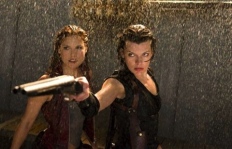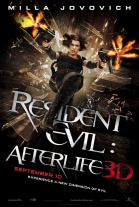Resident Evil: Afterlife
|  Before heading into Resident Evil: Afterlife, the fourth installment in the seemingly unstoppable video-game-based franchise, I had to remind myself that I had, in fact, seen two of the previous three installments, not just one. I had skipped out on 2007’s Resident Evil: Extinction, and perhaps as a result my mind had blended the previous two films, 2002’s Resident Evil and 2004’s Resident Evil: Apocalypse, into a singular bad experience. Thus, my expectations were admittedly not particularly high this time around, and while the opening 15 minutes of the movie actually exceeded all of my worst assumptions and fears, the rest of the film seemed, with some glaring exceptions, the best of what I have seen of the series. Before heading into Resident Evil: Afterlife, the fourth installment in the seemingly unstoppable video-game-based franchise, I had to remind myself that I had, in fact, seen two of the previous three installments, not just one. I had skipped out on 2007’s Resident Evil: Extinction, and perhaps as a result my mind had blended the previous two films, 2002’s Resident Evil and 2004’s Resident Evil: Apocalypse, into a singular bad experience. Thus, my expectations were admittedly not particularly high this time around, and while the opening 15 minutes of the movie actually exceeded all of my worst assumptions and fears, the rest of the film seemed, with some glaring exceptions, the best of what I have seen of the series.Again scripted by Paul W.S. Anderson, who has written all four movies but is returning to the director’s chair for the first time since the initial movie, Afterlife continues the saga of Alice (Milla Jovovich), a biologically enhanced security guard for the massive Umbrella Corporation. Umbrella, the end all-be all of corporate evil, has unwittingly unleashed the T-virus, a rampaging biological horror that has decimated the entire world, turning most of its population in flesh-eating zombies. Apparently, at the end of Extinction Alice was cloned, and at the beginning of Afterlife she and her army of like-minded selves descend into Umbrella’s massive bunker beneath Tokyo to blow it to smithereens. They are successful in this endeavor, with the only hitch being that Umbrella’s chief villain, Albert Wesker (Shawn Roberts, doing his best Agent Smith impression), escapes and manages to inject Alice with a serum that effectively negates her biological enhancements and makes her, for all intents and purposes, “human” again (although she still manages to survive a massive air collision that would kill any other human). The manner in which Anderson stages the film’s opening sequence is mind-numbing in both its visual repetitiveness and its unapologetic mimicry. There is not a single shot or moment that is anything other than derivative, and the fact that the momentum is constantly interrupted with egregious slow motion makes it feel that much longer and therefore more insufferable. The film settles down after that, as Alice flies to Alaska to try to find Arcadia, a supposed safe haven from the virus. Instead, she finds Claire Redfield (Ali Larter), a friend from the previous film who has sustained some kind of trauma and is now amnesiac. Alice and Claire then travel to the smoldering ruins of Los Angeles, where they join a small band of surviving humans who have holed up in the upper levels of the Citadel, which is otherwise surrounded by thousands and thousands of zombies, some of which have begun tunneling beneath the military prison and are threatening to come up through its flooded bowels. The fact that these sequences offer a temporary respite from the amped-up action aesthetics makes them the best in the film, as there is modicum of character development involving Claire’s imprisoned brother Chris (Wentworth Miller), a former basketball superstar named Luther West (Boris Kodjoe), and a smarmy Hollywood producer (Kim Coates) who is ego-centrically unaware that the overall change in world order means that he no longer wields power. The respite is short-lived, however, as it isn’t long before zombies with tentacled mouths are bursting out of the floor and an unexplained hooded behemoth swinging a giant axe is pounding at the gates. While Anderson’s obsessive reliance on Matrix-style slow motion is as embarrassing as it is momentum killing (especially in his use of three-dimensional frozen imagery, which was parodied so hilariously just a few months ago in The Other Guys), he does display a few moments of wit and a surprising willingness to subvert expectation, whether it be the prospect of Alice taking a shower (which is rudely interrupted by both a peeping tom and a sudden attack of zombies) or an escape plan involving an armored urban assault vehicle that never materializes. Unfortunately, what little wit the film has is ultimately trammeled beneath the heels of Anderson’s relentless need to push everything way, way over the top without any sense of self-consciousness or humor (I suspect that Alice’s swinging from the roof of the Citadel is some kind of shout-out to Die Hard, but it is done so gracelessly that I hate to associate the two films). It also doesn’t help that Jovovich is so utterly bland in the central role; she seems unaware that one can be a bad-ass and have a personality at the same time, which is why her various quips (“I’m not on the menu!”) ring so hollow. Fans of the series will be elated to know that the final image is as open-ended as all the others, leaving the barn door wide open for a fifth installment, and one can only hope that the series will finally find a way to distinguish itself instead of merely riding on what came before. Copyright ©2010 James Kendrick Thoughts? E-mail James Kendrick All images copyright © Screen Gems |
Overall Rating: 
 (1.5)
(1.5)


